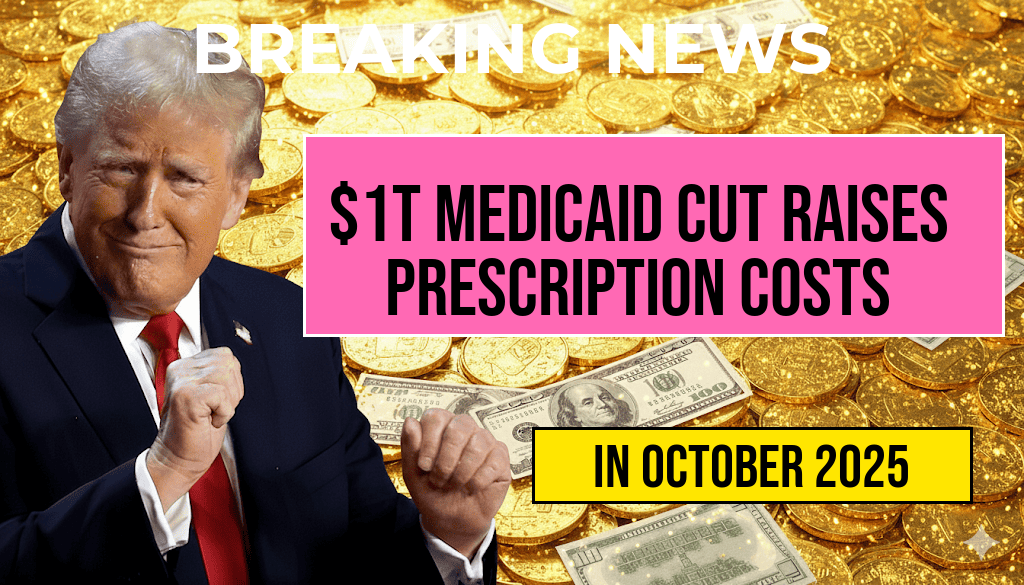Washington Post Reports $1 Trillion Medicaid Cut: Why a $300 Prescription Is Now More Expensive
The announcement of a $1 trillion reduction in Medicaid funding has sent shockwaves through the healthcare industry, raising fears that millions of vulnerable Americans will face reduced access to essential medications and services. According to a recent report by The Washington Post, this drastic budget cut could translate into significant increases in out-of-pocket costs for patients, including the price of common prescriptions such as a $300 medication now becoming notably more expensive. As policymakers grapple with the implications, many experts warn that the ripple effects may worsen health disparities and strain already overstretched healthcare providers.
The Scope of the Medicaid Funding Reduction
The proposed cuts, amounting to approximately $1 trillion over the next decade, represent one of the most significant reductions ever proposed for Medicaid, the federal and state program that provides health coverage to over 80 million Americans. The budget adjustments aim to reshape Medicaid’s structure, shifting administrative responsibilities and imposing new spending caps. However, critics argue that these measures threaten to undermine the program’s core mission of providing affordable healthcare to the nation’s low-income population.
Impact on Prescription Drug Costs
One immediate concern revolves around prescription drug affordability. Medicaid often negotiates drug prices directly with pharmaceutical companies, securing discounts that help keep medications affordable for enrollees. With the impending budget cuts, states may face increased financial pressure, potentially leading to less bargaining power and higher medication costs for patients.
| Medication | Cost Before Cuts | Estimated Cost After Cuts |
|---|---|---|
| Hypertension Medication | $50 | $75 |
| Diabetes Insulin | $100 | $150 |
| Common $300 Prescription | $300 | Estimated $400–$450 |
This table illustrates how the cost of essential medications could increase, with some drugs potentially becoming 50% more expensive for Medicaid beneficiaries. The rising costs may force many to choose between medication and other necessities, exacerbating health inequities.
Why Are Prescription Prices Increasing?
The core issue stems from reduced Medicaid reimbursements and tightened state budgets. Pharmaceutical companies often rely on Medicaid’s expansive purchasing power to negotiate discounts, but as funding diminishes, states may be less able to enforce favorable pricing agreements. Additionally, drug manufacturers might prioritize private insurance markets, where profits are higher, over Medicaid, leading to reduced discounts for low-income populations.
Moreover, some analysts point to the broader implications of budget cuts on pharmacy networks and medication access. Pharmacies serving Medicaid populations may face operational challenges, reducing availability or increasing prices to offset financial shortfalls. These dynamics collectively contribute to higher out-of-pocket expenses.
Broader Healthcare Consequences
Beyond medication costs, the Medicaid reductions threaten to curtail access to vital health services, including preventive care, mental health support, and chronic disease management. The Medicaid program plays a crucial role in addressing social determinants of health, and cutting its budget risks reversing gains made in reducing healthcare disparities.
- Delayed or forgone care due to cost increases
- Increased emergency room visits for untreated conditions
- Higher long-term healthcare costs for society
Policy Reactions and Public Response
Legislators, healthcare providers, and patient advocacy groups have voiced strong opposition to the proposed cuts. Many argue that reducing Medicaid funding contradicts efforts to improve health outcomes and manage healthcare costs in the long run. The American Medical Association warned that such reductions could lead to a “public health crisis” among vulnerable populations.
Meanwhile, some policymakers contend that the cuts are necessary to curb federal spending and promote fiscal responsibility. They emphasize reforms aimed at reducing fraud and waste within Medicaid, although critics counter that the proposed reductions are too severe and risk destabilizing the program.
Looking Ahead
The debate over Medicaid funding is likely to intensify as the Biden administration and Congress negotiate the budget details. Experts suggest that without safeguards, vulnerable populations may bear the brunt of these financial adjustments, facing increased costs and diminished access to care. For individuals relying on Medicaid for critical medications, the prospect of higher prices underscores the importance of policy vigilance and advocacy.
More comprehensive analyses and updates can be found on authoritative sources such as HealthCare.gov and the Kaiser Family Foundation.
Frequently Asked Questions
What is the main focus of the Washington Post article?
The article discusses the $1 trillion Medicaid cut and how it impacts healthcare costs, specifically making a $300 prescription more expensive for patients.
How does the Medicaid cut affect prescription drug prices?
The Medicaid cut leads to reduced funding, which can result in higher out-of-pocket costs for patients, making medications like a $300 prescription more expensive.
Why are prescription costs increasing despite existing healthcare policies?
Changes in Medicaid funding and policy adjustments are contributing to increased prescription costs, impacting affordability for many patients.
Who are most affected by the proposed Medicaid cuts and increased drug prices?
Patients relying on Medicaid for prescriptions and healthcare services are most affected, especially those needing expensive medications like the $300 prescription.
What are the potential implications of the Medicaid cut on overall healthcare access?
The $1 trillion Medicaid cut could reduce access to essential healthcare services and medications, potentially leading to worse health outcomes for vulnerable populations.

Leave a Reply